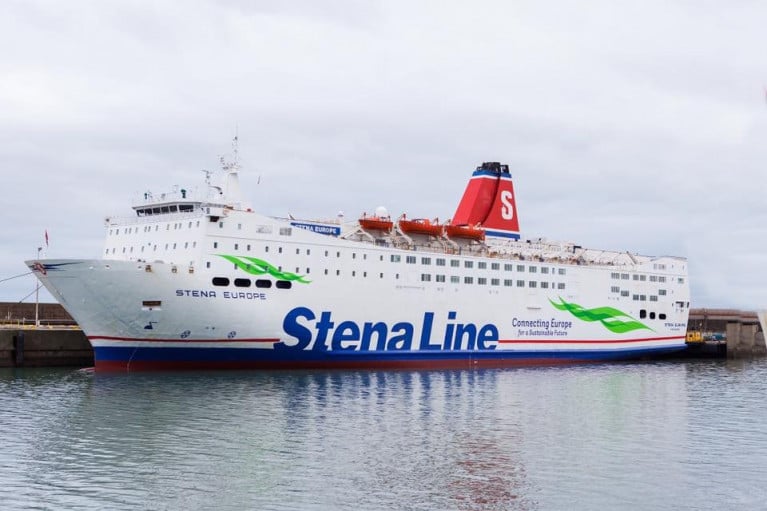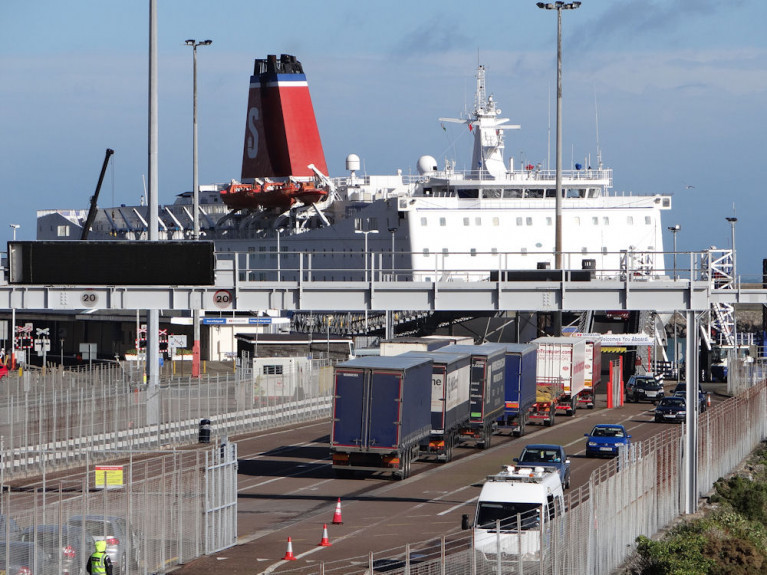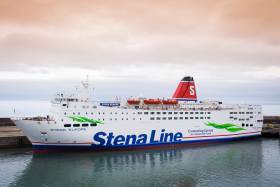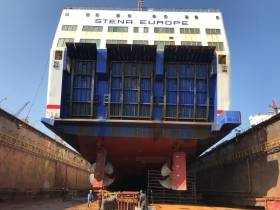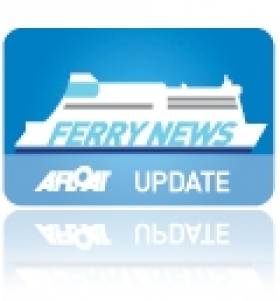Displaying items by tag: Stena Europe
Stena Line’s ‘Technical Issues’ Linger on Rosslare-Fishguard Route after Six-Week Suspension
Stena Line’s Rosslare-Fishguard route, which was abandoned altogether for nearly six weeks, is still facing difficulties maintaining its southern corridor service between the Irish and Welsh ports.
As the Irish Independent reports, maintenance work at the Welsh port's linkspan berth has meant that the ropax Stena Nordica, which was announced as the “permanent” ferry on the Rosslare-Fishguard route last year, is unable to berth at the port at the moment.
In the meantime, Afloat adds that the ‘Nordica’ is running Dublin-Holyhead sailings, allowing the route’s routine ferries to go for an annual overhaul. The service on the St. George’s Channel was suspended for a number of weeks while the ferry operator carried out a reshuffle, which culminated in a return for the 1981-built Stena Europe. The veteran vessel, which had operated on the route for 21 years after replacing cruiseferry Koningin Beatrix in March 2002, served the Ireland-Wales route up until last July.
There were also mechanical issues, which meant that the suspension of the Rosslare-Fishguard crossing went on for nearly six weeks while the ageing ferry went for repairs at Cammell Laird on Merseyside. On completion of works at the facility’s Tranmere Wet Basin, Afloat tracked the ferry to nearby Liverpool Docks where it remained for short period.
Stena Europe, however, was eventually able to resume service last month. Among recent passengers including those on 'foot' were enthusiastic Welsh rugby fans that travelled the Irish Sea route to enjoy the Wexford pubs for their Six Nations clash with Ireland.
The resumption of the service is welcomed by many; however, there have again been a number of issues that have resulted in major delays and the cancellation of some sailings.
More from the newspaper here on the route operated by the long-serving Stena Europe as seen above in 2010 with a previous livery scheme.
Afloat's Jehan Ashmore travelled on M.V. Scillonian III, under the command of Captain Victoria Bolitho, who has the unique honour of being the first female appointed in this ferry role in the 103 year history of the Isles of Scilly Steamship Company.
Upon visiting the bridge or 'wheelhouse' given its traditional timber wheel, the Captain introduced herself as Vicky and this year is her third season on the Scillonian III, a 485 passenger capacity ferry spread across two full decks and partially using a lower deck. Whereas forward is a cargo hold with a crane for handling vehicles and above on deck small containers are immediately located ahead of the three deck superstructure.
The 1,255 gross tonnage Scillonian III has served for more than 45 years as a vital life-line for around 2,000 Islanders living on five inhabited islands out of the archipelago's total of 140 which are located 24 nautical miles offshore of Cornwall in south-west England.
In addition the passenger ship purpose built in 1977 is popular with tourists on the only sea route to the scenic Scilly Isles. This is a distance of 37 nautical miles between Penzance Harbour and Hugh Town, St. Mary's, the largest island.
The service is the longest domestic passenger route along the UK's south coast where Scilly offers a visitor experience often described as 'an outer world' given its allure of white sandy deserted beaches great for water pursuits. In addition to marine wildlife including puffins, the islands exotic plants flourish in a sub-tropical climate.
 In the wheelhouse, where Captain Victoria Bolitho is at the controls when approaching St. Mary's Quay, Hugh Town on St. Mary's where also inter-island ferries congregate Photo: Jehan Ashmore
In the wheelhouse, where Captain Victoria Bolitho is at the controls when approaching St. Mary's Quay, Hugh Town on St. Mary's where also inter-island ferries congregate Photo: Jehan Ashmore
During the 2 hour 40 minute passage, the route takes a coastal course off Cornwall including Land's End as seen when entering the wheelhouse where the second officer was present and later joined by helmsman in approaching Hugh Town, St. Mary's. (See above photo with ship's wheel out of frame)
It was soon abundantly clear Vicky's passion for the sea, as the native of Cornwall exuded enthusiasm by recalling her childhood when taking to the water on boats in coastal waters with her father, which would ultimately lead to her career at sea.
In 2019, Scillonian III welcomed its 4.5 millionth ferry passenger aboard and in the following year the Isle of Scilly Steamship Company celebrated its centenary in March, 2020. At the end of 2021, the company announced that Victoria (33) would take over the command of Scillonian III from Captain Pete Crawford after a career spanning four decades.
At the time of her appointment she commented, “I am extremely proud to become Master of Scillonian III. It is an instantly recognisable and hugely important ship, loved by so many who travel on her".
She added “It will be an honour and privilege to sit in the captain’s seat, but especially to be taking over from Pete, who will be a hard act to follow. He has taught me so much, and I will miss him greatly".
So in January, 2022, Captain Victoria Bolitha took to the helm of the company's third passenger/cargo ferry to bear the company's historic name of Scillonian III. The veteran vessel (to be replaced from 2026) was built in the West Country in neighbouring Devon, at Appledore Shipbuilders, (see further notes below).
Vicky along with a crew of 18 work as a close 'family' in which 8 of the crew are catering-related given the two cafe outlets among several lounge areas and a baby changing room. While other crew members are a chief engineer and second engineer and deckhands who also manage cargo-hold operations. This involves handling passenger baggage using 20ft containers stored on either side of the cargo hold rather than unnecessary clogging up of passenger areas.
 Scillonian III alongside St. Mary's Quay, Hugh St. Mary's during cargo unloading operations which involve passenger baggage and equipment stored in containers for fast and efficient turnarounds in between the 2 hour 40 minute crossing from the UK mainland Photo: Jehan Ashmore
Scillonian III alongside St. Mary's Quay, Hugh St. Mary's during cargo unloading operations which involve passenger baggage and equipment stored in containers for fast and efficient turnarounds in between the 2 hour 40 minute crossing from the UK mainland Photo: Jehan Ashmore
In the above photo at St. Mary's, the hold's hatch cover is where the crane is mounted and which is also used to lift in and out vehicles of up to two that are placed in the cargo hold. Afloat noted a container unloaded at St. Mary's was bound for another inhabited island, as it was marked: 'St. Martins, Divers, Out, SCIII' indicating it's destination, contents and ship, as the company operates a freight vessel, Gry Maritha also on the same route.
To become Captain, Vicky trained at the prestigious Warsash Maritime Academy, part of Solent University, Southampton, now Warsash Maritime School (see: Trinity House story). She joins an elite group of seafarers after gaining a Master’s unlimited certificate which is the highest qualification that can be given for professional mariners.
Only just two per cent of merchant navy seafarers are women and notably an even smaller number become Master mariners. With Vicky's master certificate, she is qualified to take on the command of virtually any ship, of any size and to sail anywhere in the world.
Both Vicky and crew work to a roster of two week on/two weeks off on the route which runs on a seasonal basis from March to November. When on shore leave, Captain David Redgrave takes over the role with the ship's second crew complement.
Prior to becoming Captain, Vicky for the past two and half years was the Scillonian III’s Chief Officer and before that for half a year serving in the same role with the freight vessel Gry Maritha. The 590 gross tonnage 40m freighter provides an essential year-round service for the islanders. While in the off season months and throughout the year, passengers can also use the company's Sky-Bus services from airports in Cornwall and Devon.
Overall between sea and air links, the Isles of Steamship Company has more than 200 staff and crew, representing one of the largest employers in Cornwall.
Captain's career path included Irish Sea ferry Stena Europe
In addition Vicky's maritime career before joining the Steamship Company, involved working almost a decade ago on several ships among them Condor's freight ferry Commodore Goodwill on a UK-Channel Islands-France rotation.
But her first passenger ferry was the 24,828 tonnes Stena Europe between Rosslare-Fishguard which this year was replaced on 13 July. The 149m ferry carried 480 cars or 1,120 lane metres of freight and up to 1,400 passengers and accommodation in 452 berths.
Replacing the St. George's Channel route ferry of the past 21 years is the ropax Stena Nordica which Afloat tracked on Friday, 28 July, having returned overnight from Belfast, to resume service on the southern Ireland-Wales route, see previous coverage.
After completion of Stena Europe's farewell sailing to Rosslare, Afloat also tracked the ferry depart Wexford on 14 July, as it happened heading for Cornwall, to A&P Falmouth dockyard so to prepare for a charter across the Strait of Gibraltar on a Spain-Morocco route.
Also at the refit, ship repair facility but docked in a dry-dock is CLdN's ro-ro freight ferry Mazarine which during a Cork to Zeebrugge passage on 10 July, lost power and grounded near the Wolf Rock Lighthouse. This led to the RNLI lifeboats dispatched and also attending the scene was Scillonian III which was on standby to take crew off, but this was not required. The CldN vessel was towed to Falmouth from the port's based tugs.
Another vessel at Falmouth dry-docks is the Serco tug, SD Careful which arrived from the UK Royal Navy Base at Dartmouth beside Plymouth which along with fleetmates provide towage escort duties including foreign naval visitors.
Scillonian III built by Appledore Shipbuilders, Devon
The third Scillonian III for the Isle of Scilly Steamship Company was launched by Appledore Shipbuilders Ltd as a purpose built passenger/cargo ship which entered into service in May, 1977. The 67.70m length overall (LOA) vessel is powered by Mireless Blackstone engines, which drive twin screw propellers giving a speed of 15.5 knots.
Readers from Ireland would be more familiar with this same north Devon shipyard, as from 1999 and under different ownership's, the shipyard downriver of Bideford has built several offshore patrol vessels (OPV) for the Naval Service.
The shipyard at Bidna first built for the Irish Department of Defence a pair of Naval Service offshore patrol vessels of the OPV P50 class, otherwise known as the 'Roisin' class, each of 78.84 (LOA).
A further order was placed for the larger variant, the OPV P60 class which saw a quartet of this series completed and which are also referred as the 'Playwright' class.
The facility in recent years was acquired by Harland & Wolff Group which asides its iconic origins in Belfast, the group has facilities located in Arnish, near Stornaway on the Isle of Lewis in west Scotland and on the opposite east coast at Methil on the Firth of Forth estuary.
Stena Europe Departs Homeport of Fishguard for the Last Time With End of an Era Sailing to Rosslare
In south-west Wales it was an end of an era at Fishguard yesterday, 13 July, as a much-loved Stena ferry left the Pembrokeshire port for the last time ever after more than two decades of service to Rosslare.
As the Western Telegraph reports, the Stena Europe has been operating on the St. Georges Channel run for the last 21 years, having originally served in Scandinavia and the North Sea for the Swedish based ferry company.
The veteran vessel dating to 1981 Afloat adds was the oldest ferry operating on the Irish Sea and was a twin of another former Rosslare ferry, Normandy which Irish Ferries had operated to France but the continental route is now based out of Dublin served by the W.B.Yeats.
Facilities on the Stena Europe included a tiered stern lounge comprising of a bar, stage and dance floor which was a pioneering feature that also appeared increasingly in that decade on cruiseships.
In more recent years, Stena introduced their Hygge Lounge. Also onboard is the Stena Plus lounge, a duty free shop, family lounge, children's playroom, cinema, self-service restaurant, ensuite cabins and extensive exterior decks.
At 24,828 tonnes the 149 metres ferry carried 480 cars or 1,120 lane metres of freight and up to 1,400 passengers and accommodation in 452 berths.
After the final sailing to Rosslare, the ferry departed Wexford, Afloat also adds today, 14 July, for Falmouth in Cornwall. This is to enable a dry-docking at A&P Falmouth of the ferry before a charter on the Gibraltar Straits takes place on a route between Spain and Morocco.
Replacing the ferry is the ropax Stena Nordica, which took up the service from Rosslare yesterday evening.
The ropax is no stranger to the Irish Sea as it operated on Dublin-Holyhead route between 2008-2015 and in recent years acted as a relief ferry also on the North Channel and the Rosslare-Fishguard route.
The newer 'Nordica' built in 2000 is of 24,206 tones and 170m long and can take 450 passengers, 300 cars or 1,700 lane metres of freight. This means that the ferry takes less passengers but more freight.
There are 152 cabins with a total of 222 berths.
For more on the replacement ferry on the Wales-Ireland route click here.
Ferry company, Stena Line is to resume sailings from Fishguard to Rosslare this Sunday, 5 March, just over three weeks since Stena Europe was taken off the Wales-Ireland route due to an engine room blaze.
As the Western Telegraph writes, the port in Pembrokeshire is to welcome the return of the Stena Europe following repairs to the engine room when the blaze took place off the Welsh coast on Saturday, 11 February.
Dating to 1981, the veteran vessel was repaired at the Cammel Laird shipyard, Birkenhead at the Tranmere Basin as Afloat previously reported and where a planned maintenance also took place.
Stena Europe which at more than 40 year's old, has for half that time spent a career on the Wales-Ireland route, is to be replaced in July by the 2001 built Stena Nordica.
This ropax ferry which is based on the Baltic Sea, Afloat adds previously served on the Irish Sea but on the Holyhead-Dublin route until replaced in 2015. Since then the ropax has returned to the Irish Sea as a relief ferry during annual winter dry-dockings.
As for the St. Georges Channel route, Stena Europe’s arrival in Fishguard is scheduled for this Saturday in readiness for the next day’s first passenger and freight crossing at 1300 on Sunday. On the same day, the ferry is to return from Rosslare at 18.15.
Stena Line’s trade director Irish Sea, Paul Grant, said: “We are very pleased to have Stena Europe back sailing from this Sunday, for its last few months on our Fishguard – Rosslare route; until it is replaced by a new look Stena Nordica in the summer.
"Thank you to all our customers for their patience.”
Fishguard Ferry Off-Service Undergoes Repairs on Merseyside Shipyard
The Rosslare-Fishguard Stena Line ferry, which following an engine-room blaze that occurred over a week ago, is in for repairs at a shipyard on Merseyside, writes Jehan Ashmore.
Stena Europe is berthed in the Tranmere basin at the Cammell Laird shipyard in Birkenhead (which is nearby to the ferry terminal/see story).
As Afloat previously reported the crew were able to extinguish the fire which took place as the ferry was nearing the Port of Fishguard in Pemrokeshire.
All passengers and crew were unharmed having arrived to the Welsh port and from where rescue authorities were on hand to also assist as a precaution.
An investigation as to the cause of the fire is underway on the 1981 built ship which is the oldest ferry on the Irish Sea and of the Stena fleet. The Swedish owned company has a route network also on the North Sea and throughout Scandinavia.
While Stena Europe is away from the St. George's Channel route, scheduled maintenance works will also take place in Birkenhead on the ferry which arrived on Merseyside last Tuesday. This following an overnight passage from Fishguard.
According to the Stena website, sailings on the Rosslare-Fishguard route up until 26th February are suspended and all traffic (including foot passengers) will be accommodated on an alternative sailing.
This involves customers transferring to rival operator Irish Ferries on the Rosslare-Pembroke Dock route served by the chartered in Blue Star 1.
In addition Stena have facilitated those travelling with another alternative by travelling instead on their Dublin-Holyhead route.
A Stena Line ferry is back on the Fishguard to Rosslare run after six weeks in dry dock for ‘complex repairs’ that were discovered to be necessary during a routine inspection.
The ferry Stena Europe was initially taken off the Fishguard to Rosslare run in the middle of May when Stena confirmed that the ferry had been sent for repairs at the Harland and Wolff shipyard in Belfast 'following a routine inspection'.
No replacement vessel was forthcoming, and sailings were initially cancelled until May 21.
However, at the end of May the company said that the repairs were still ongoing, with the ferry due to be back on the run by initially by June 4 and then June 24.
The Western Telegraph has more on the ferry's resumption on the St. Georges Channel link.
Stena Europe to Resume Fishguard-Rosslare Service on 24 June
Stena Europe is still out of action as a 'combination of complex engineering tasks and issues sourcing parts' have caused the ferry to remain in dry dock longer than anticipated.
According to the Western Telegraph, the Stena Europe will have been in dry dock for over a month.
The ferry was initially taken off the Fishguard to Rosslare run in the middle of May when Stena confirmed that the ferry had been sent for repairs at the Harland and Wolff shipyard in Belfast 'following a routine inspection'. Sailings were initially cancelled until May 21.
However, at the end of May the company said that the repairs were still ongoing, with the ferry due to be back on the run by June 4.
No replacement vessel has been put on the Fishguard to Rosslare run in the meantime.
The latest announcement from Stena gives June 24 as the date for when the Europe will be up and running.
Click here for more of the story.
Stena Europe Returns from Outside Europe With Scheduled Services on Rosslare-Fishguard Route
On completion of an extensive refit programme at an Asian shipyard located in Turkey and at a dock in Liverpool, the UK, the Stena Europe has recently resumed its scheduled sailing services on the Rosslare - Fishguard route.
Afloat.ie adds the veteran ferry returned to service later than expected as an original completion timeframe was set for July before the high-season ended on the St. Georges Channel service linking Ireland and Wales.
As alluded by the operator, Stena Europe's upgrade programme took longer than had been anticipated but as Stena Line’s Trade Director (Irish Sea South) Ian Davies said, the upgraded vessel will now offer a significant improvement in customer care. “I know there has been a certain amount of frustration with the delayed return of the Stena Europe, a very popular vessel with both our freight and travel customers. We had planned for a number of improvements and additions throughout the ship both of a technical and customer-facing nature, but we did encounter a number of challenges which impacted on our works delivery schedule for which I’d like to apologies to our customers. “
Ian Davies added: “During the refit period our cover vessel the Stena Nordica did a sterling job ensuring we maintained our sailing schedule on Fishguard – Rosslare and I would like thank the Captain and crew of the Stena Nordica for their efforts. We are now all looking forward to welcoming the Stena Europe back and I know a lot of our regular customers are looking forward to seeing the improvements.”
“Apart from a number of technical upgrades our freight customers will be particularly pleased to hear that we have altered our deck height to be able to accommodate the increasing trend for high sided trailers and for our travel customers we have also added a new Hygge Lounge which offers luxury reclining seats set in a private, ultra-stylish but cosy surrounding, an upgraded Retail Shop and a refurbished Happy children’s play area to name a few changes.”
As for the whereabouts of Stena Nordica, Afloat.ie yesterday tracked the former Dublin-Holyhead ferry (displaced by Stena Superfast X in 2015) make a repositioning voyage from Rosslare Europort when transitting through the English Channel bound for Rotterdam (Europoort), The Netherlands.
The Japanese built ropax completed the passage having arrived in Europe's largest port today.
Rosslare-Wales Route Ferry Departs Europe to Undergo Significant Refit Upgrade in Turkey
#ferries - The Rosslare-Fishguard ferry Stena Europe is off service and is currently undergoing a significant three-month refit visit at a shipyard located outside Europe.
Last month Afloat monitored the Ireland-Wales ferry having left familiar waters when off Spain and prior to taking on bunkers in Gibraltar and entering the Meditteranean. According to Stena Line the ferry is at the Gemak Shipyard in Tuzla. The yard is located in the province of Istanbul, Turkey on the Asian side of the city.
The 24,828 gross tonnage ferry which was introduced on the St. Georges Channel route in 2002 is scheduled to return late June 2019 and during the visit a number of upgrade projects will be completed.
One of the most significant projects to be undertaken includes modifications to the deckhead levels on the main vehicle deck to allow for the carriage of full-height trailers across the whole of the main vehicle deck. Prior to arrival at the Turkish shipyard, Stena Europe was restricted to carrying full-height trailers on its port side only.
Other works will include the renewal of the majority of the ship’s windows, engine and hull overhauls including blasting the whole hull to remove all the existing old paint work to improve fuel efficiency and the ships appearance.
Internally, the passenger stairwells will be revamped, a redesign of the Barista Coffee outlet, as well as upgrades to the passenger Information Desk and other decor improvements. During the refit period, the Stena Europe has been replaced by the Stena Nordica on the Rosslare-Fishguard service.
Ian Davies, Stena Line Trade Director (Irish Sea South) said: “Our ongoing ship refit programme is an important part of our business operation ensuring that our fleet operates to its maximum efficiently and is further evidence of Stena Line’s rolling investment programme for the region. The Stena Europe is an important part of our Irish Sea South fleet and we look forward to welcoming a revamped vessel back to our Rosslare-Fishguard service in the summer with the capacity to accommodate even more full-height trailers while still carrying up to 1, 400 passengers.
This is an important year for Stena Line on the Irish Sea as preparations are made to receive the first of its new generation E-Flexer series vessels, the Stena Estrid, which is scheduled to enter service on the Dublin to Holyhead route in early 2020, the first of three new E-Flexer vessels bound for the Irish Sea region..
Stena Line is the largest ferry operator on the Irish Sea, operating routes between Ireland and Britain, including Dublin to Holyhead, Belfast to Liverpool /Heysham and Belfast to Cairnryan. In addition a continental direct service to France between Rosslare and Cherbourg.
Dublin-Bound Ferry Forced to Return to Anglesey
#FerryReturns – A ferry on the Stena Line Holyhead-Dublin Port had to return to Anglesey after reports of a fire on board.
Emergency services were called after smoke was spotted coming from a refrigeration unit on the car deck of the Holyhead to Dublin Stena Europe ferry. No fire was found and the Stena Europe was able to leave for Dublin. For more BBC North Wales reports.
Afloat.ie adds that the Stena Europe has docked in Dublin Port this afternoon having completed the delayed sailing from Wales.
Stena Europe normally operates the Rosslare-Fishguard route and yesterday the ferry made a repositioning voyage to Dublin Port.
The veteran ferry built in 1981 is covering Dublin-Holyhead sailings otherwise operated by Stena Nordica which went off service for dry-docking. The route's second ferry, Stena Adventurer maintains running on schedule.
Stena Europe is due to have an annual refit in Cammell Laird, Birkenhead. Currently there are no sailings between Rosslare-Fishguard until her return on 9 December. An interim replacement service from Rosslare is running instead to Pembroke Dock and this route is operated by Irish Ferries.



























